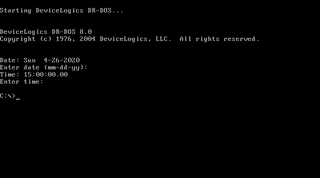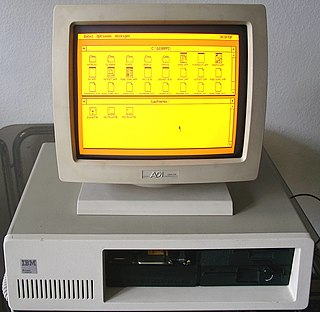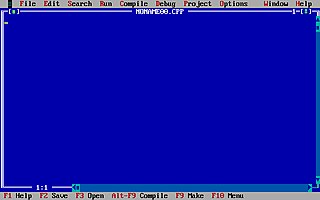
Lotus 1-2-3 is a discontinued spreadsheet program from Lotus Software. It was the first killer application of the IBM PC, was hugely popular in the 1980s, and significantly contributed to the success of IBM PC-compatibles.
XyWrite is a word processor for MS-DOS and Windows modeled on the mainframe-based ATEX typesetting system. Popular with writers and editors for its speed and degree of customization, XyWrite was in its heyday the house word processor in many editorial offices, including the New York Times from 1989 to 1993. XyWrite was developed by David Erickson and marketed by XyQuest from 1982 through 1992, after which it was acquired by The Technology Group. The final version for MS-DOS was 4.18 (1993); for Windows, 4.13.
Turbo Pascal is a software development system that includes a compiler and an integrated development environment (IDE) for the Pascal programming language running on CP/M, CP/M-86, and DOS. It was originally developed by Anders Hejlsberg at Borland, and was notable for its extremely fast compiling times. Turbo Pascal, and the later but similar Turbo C, made Borland a leader in PC-based development.

DR-DOS is a disk operating system for IBM PC compatibles. Upon its introduction in 1988, it was the first DOS attempting to be compatible with IBM PC DOS and MS-DOS.
Lotus Symphony was an integrated software package for creating and editing text, spreadsheets, charts and other documents on the MS-DOS operating systems. It was released by Lotus Development as a follow-on to its popular spreadsheet program, Lotus 1-2-3, and was produced from 1984–1992. Lotus Jazz on the Apple Macintosh was a sibling product.

GEM is an operating environment which was created by Digital Research (DRI) since 1984 for use with the DOS operating system on Intel 8088 and Motorola 68000 microprocessors.

AppleWorks is an integrated office suite containing a word processor, database, and spreadsheet. It was developed by Rupert Lissner for Apple Computer, originally for the Apple II platform and launched in 1984, and was later reworked for the Macintosh platform.
Framework, launched in 1984, was a office suite to run on the (x86) IBM PC and compatibles with the MS-DOS operating system.

Multiuser DOS is a real-time multi-user multi-tasking operating system for IBM PC-compatible microcomputers.
Merge is a software system which allows a user to run DOS/Windows 3.1 on SCO UNIX, in an 8086 virtual machine.

Turbo C++ is a discontinued C++ compiler and integrated development environment originally from Borland. It was designed as a home and hobbyist counterpart for Borland C++. As the developer focused more on professional programming tools, later Turbo C++ products were made as scaled down versions of its professional compilers.
Omnis Studio is a rapid application development (RAD) tool that allows programmers and application developers to create enterprise, web, and mobile applications for Windows, Linux, and macOS personal computers and servers across all business sectors.

pfs:Write is a word processor created by Software Publishing Corporation (SPC) and published in 1983. It was released for IBM PC compatibles and the Apple II. It includes the features common to most word processors of the day, including word wrapping, spell checking, copy and paste, underlining, and boldfacing; and it also a few advanced features, such as mail merge and few others. The product was considerably easier to both learn and use than its more fully featured and expensive competitors: WordPerfect, Microsoft Word, and XyWrite.

Ability Plus Software is a software development company founded in 1991 for the purposes of developing and marketing Ability-branded products: Ability Office, an office suite for Microsoft Windows and earlier, Ability Plus — an integrated package running under DOS.
This article presents a timeline of events in the history of 16-bit x86 DOS-family disk operating systems from 1980 to present. Non-x86 operating systems named "DOS" are not part of the scope of this timeline.

MS-DOS is an operating system for x86-based personal computers mostly developed by Microsoft. Collectively, MS-DOS, its rebranding as IBM PC DOS, and a few operating systems attempting to be compatible with MS-DOS, are sometimes referred to as "DOS". MS-DOS was the main operating system for IBM PC compatibles during the 1980s, from which point it was gradually superseded by operating systems offering a graphical user interface (GUI), in various generations of the graphical Microsoft Windows operating system.
Ability Office is an office suite developed by Ability Plus Software and distributed and marketed by Ability Software International and which consists of a word processor, spreadsheet, database, modules for presentation and photo or image editing, plus a photo/image organiser and vector line drawing application. The current version (V6) offers a level of compatibility with Microsoft Office, allowing users to create, load from and save both to Microsoft Office 2010 and earlier file formats. In the same way, the photo and image editing application will create, load from and save to Adobe Photoshop (*.psd) file formats, together with other mainstream graphical file types.
Synex Systems Corporation, a subsidiary of Synex International Inc. was formed in 1983 in an effort to develop software for the microcomputer market and was run by Synex International Vice President Murray Hendren until 1992. In 2002, Synex Systems was acquired by privately owned Lasata Software of Perth, Australia. In 2005, Lasata was acquired by UK based Systems Union. In 2007, Systems Union was acquired by privately held Infor Global Solutions, a U.S. company that specializes in enterprise software.
Software Publishing Corporation (SPC) was a Mountain View, California-based manufacturer of business software, originally well known for its "pfs:" series of business software products, it was ultimately best known for its pioneering Harvard Graphics business and presentation graphics program.








